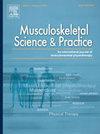Limited association between central pain processing and clinical outcomes in non-specific chronic neck pain after a manual therapy intervention: A secondary analysis
IF 2.2
3区 医学
Q1 REHABILITATION
引用次数: 0
Abstract
Background
Non-specific chronic neck pain (NSCNP) is a prevalent condition causing significant disability. While manual therapy is recommended, its clinical benefits are limited. The relationship between central pain processing and treatment outcomes in NSCNP remains unclear.
Objectives
To assess whether central pain processing measures could predict manual therapy outcomes in NSCNP patients.
Design
Pre-planned secondary analysis.
Methods
Sixty-three NSCNP patients underwent a four-week manual therapy regimen. Central pain processing mechanisms were assessed using Pressure Pain Threshold (PPT), Temporal Summation of Pain (TSP), and Conditioned Pain Modulation (CPM). Clinical outcomes were measured using the Neck Disability Index (NDI), pain intensity, and the Global Rating of Change Scale (GRoC). Univariate and multivariate regression models explored associations between baseline variables and treatment outcomes.
Results
Multivariate analysis identified baseline CPM and neck pain duration as significant predictors of treatment outcome based on GRoC. A weak negative association was found between CPM and GRoC (p < 0.05), suggesting that patients with lower CPM response reported better perceived outcomes. Baseline NDI was inversely associated with changes in disability (p < 0.01). Baseline pain intensity (p < 0.01) and duration (p < 0.05) were inversely related to pain reduction, while baseline CPM narrowly missed significance. No significant associations were found between TSP, PPT, and clinical outcomes.
Conclusion
The findings suggest a limited association between pre-treatment central pain processing status and manual therapy outcomes in NSCNP patients. The lower CPM response was modestly predictive of better outcomes, contrary to expectations. Routine use of QST measures to guide treatment decisions in this population is not supported by current data.
手工治疗干预后非特异性慢性颈部疼痛的中枢性疼痛处理与临床结果之间的有限关联:一项次要分析
背景:非特异性慢性颈部疼痛(NSCNP)是一种导致严重残疾的常见疾病。虽然推荐手工治疗,但其临床益处有限。中枢疼痛加工与NSCNP治疗结果之间的关系尚不清楚。目的评价中枢性疼痛处理指标能否预测NSCNP患者手工治疗的预后。预先计划的二次分析。方法对63例NSCNP患者进行为期4周的手工治疗。采用压力疼痛阈值(PPT)、疼痛时间累积(TSP)和条件疼痛调节(CPM)评估中枢性疼痛加工机制。临床结果采用颈部残疾指数(NDI)、疼痛强度和全球变化量表评分(GRoC)来衡量。单变量和多变量回归模型探讨了基线变量和治疗结果之间的关系。结果多因素分析发现,基线CPM和颈部疼痛持续时间是基于GRoC的治疗结果的重要预测因素。CPM与GRoC呈弱负相关(p <;0.05),表明CPM反应较低的患者报告了更好的感知结果。基线NDI与残疾变化呈负相关(p <;0.01)。基线疼痛强度(p <;0.01)和持续时间(p <;0.05)与疼痛减轻呈负相关,而基线CPM几乎没有意义。TSP、PPT与临床结果之间未发现显著相关性。结论研究结果提示NSCNP患者治疗前中枢性疼痛处理状态与手工治疗结果之间存在有限的关联。与预期相反,较低的CPM反应适度地预示着更好的结果。目前的数据不支持在这一人群中常规使用QST措施来指导治疗决策。
本文章由计算机程序翻译,如有差异,请以英文原文为准。
求助全文
约1分钟内获得全文
求助全文
来源期刊

Musculoskeletal Science and Practice
Health Professions-Physical Therapy, Sports Therapy and Rehabilitation
CiteScore
4.10
自引率
8.70%
发文量
152
审稿时长
48 days
期刊介绍:
Musculoskeletal Science & Practice, international journal of musculoskeletal physiotherapy, is a peer-reviewed international journal (previously Manual Therapy), publishing high quality original research, review and Masterclass articles that contribute to improving the clinical understanding of appropriate care processes for musculoskeletal disorders. The journal publishes articles that influence or add to the body of evidence on diagnostic and therapeutic processes, patient centered care, guidelines for musculoskeletal therapeutics and theoretical models that support developments in assessment, diagnosis, clinical reasoning and interventions.
 求助内容:
求助内容: 应助结果提醒方式:
应助结果提醒方式:


